Alderamin, Alpha Cephei (α Cep), is a white main sequence star located in the constellation Cepheus. With an apparent magnitude of 2.5141, it is the constellation’s brightest star. It lies at a distance of 49.05 light years from Earth.
Star type
Alderamin is a main sequence star of the spectral type A8Vn. It has a mass 1.74 times that of the Sun and a radius 2.3 times solar. With an effective temperature of 7,740 K, it is 17 times more luminous than the Sun. The star is believed to be in the process of evolving away from the main sequence and becoming a subgiant.
Alderamin is an exceptionally fast spinner, with a projected rotational velocity of 246 km/s at the equator. It completes a revolution in less than 12 hours, considerably faster than the Sun, which takes almost a month.
Alderamin shows slight variations in brightness of 0.06 magnitudes and is a suspected Delta Scuti variable. Also known as dwarf Cepheids, Delta Scuti stars show fluctuations in luminosity as a result of both radial and non-radial pulsations of their surface.
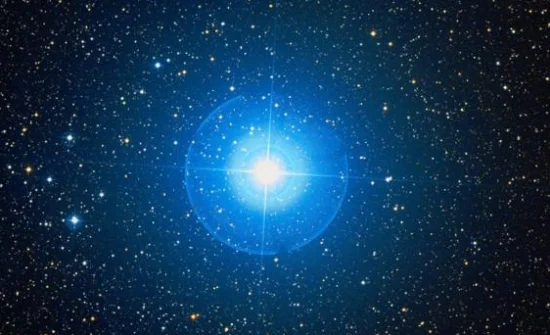
Alderamin (Alpha Cephei), image: Wikisky
Alderamin is a source of X-ray emissions, indicating significant magnetic activity, which is not typical for rapidly rotating stars.
Facts
Alderamin is one of the stars that act as indicators of true north and take their turn being the North Star due to the precession of the equinoxes. Currently, it is Polaris, Alpha Ursae Minoris, that serves as the North Star, but due to the Earth’s axial precession, it will not keep this role forever nor has it always been the nearest visible star to the north celestial pole.
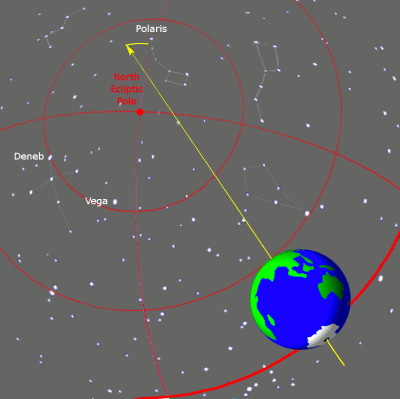
Animation of the cycle of precession of Earth’s axis, depicting the orientation of the axis in relation to the North Ecliptic Pole. Image: Wikimedia Commons/Tfr000 (CC BY-SA 3.0)
The precession cycle lasts about 25,770 years and Alderamin is one of the visible stars that come within a few degrees of the pole and mark true north for the duration of the cycle. It comes within 3 degrees of the pole, which means that it is not as accurate an indicator of true north as Polaris, which comes within only 0.5 degrees. With an apparent magnitude of 1.98, Polaris is also slightly brighter.
Alderamin last had this role around 18,000 BCE. It will become the North Star again around 7500 CE and inherit the role from Iota Cephei and Beta Cephei. These stars will share timing as the North Star after Errai, Gamma Cephei, has had its turn. The pole will be halfway between Polaris and Errai around the year 3000 CE and, by 4200 CE, Errai will come to its closest alignment with the pole. Alderamin will be succeeded by the considerably brighter Deneb in Cygnus, the 19th brightest star in the sky.
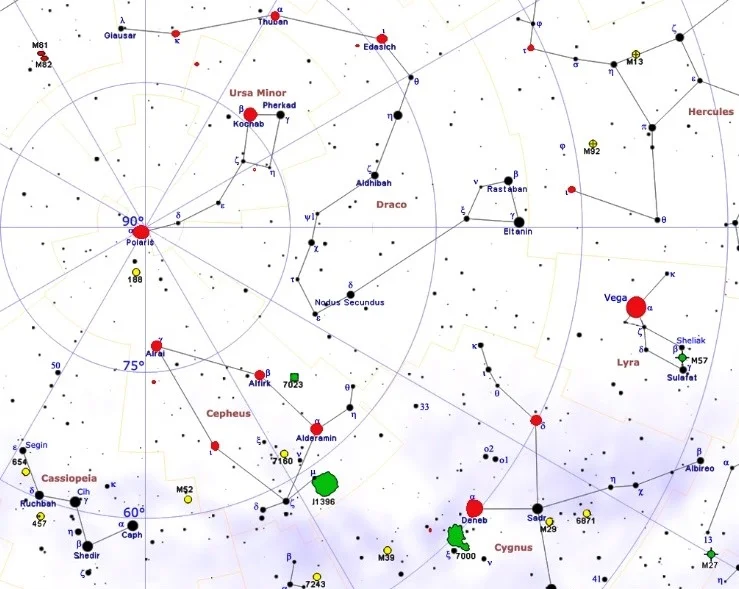
North Stars, image: Roberto Mura
Name
The name Alderamin (pronunciation: /ælˈdɛrəmɪn/) comes from the Arabic al-dhirā‘ al-yamīn, meaning “the right arm.” The phrase was contracted into Al Deraimin in the 1521 Alfonsine Tables and eventually became Alderamin.
The name was approved by the International Astronomical Union’s (IAU) Working Group on Star Names (WGSN) on July 20, 2016.
In Chinese astronomy, Alderamin is one of the stars that form an asterism known as Celestial Hook. The Chinese know the star as 天鈎五 (Tiān Gōu wu), meaning the Fifth Star of the Celestial Hook.
Timurid astronomer and mathematician Ulugh Beg (1394-1449) saw Alderamin, Alfirk (Beta Cephei) and Eta Cephei as al-Kawākib al-Firq, “the stars of the flock.”
Location
Alderamin is relatively easy to find because it is located in the same area of the sky as the bright W asterism formed by the brightest stars of Cassiopeia constellation. An imaginary line extended from Schedar through Caph leads directly toward the star. Cepheus is a relatively faint constellation and, as its brightest star, Alderamin is not difficult to spot.
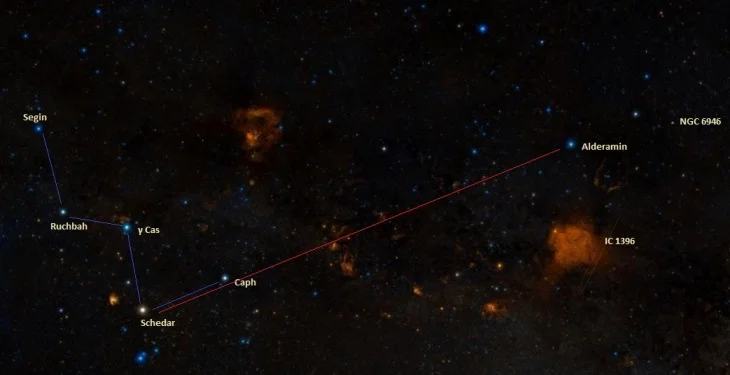
Alderamin location, image: Wikisky
Alderamin is located near the north celestial pole and therefore invisible to most southern observers. It can be seen north of latitude 27°S and is circumpolar, i.e. it never sets, for most observers north of the equator.
Alderamin lies in the vicinity of two well-known deep sky objects. The Fireworks Galaxy (NGC 6946) is a bright spiral galaxy appearing face-on, located on the border between Cepheus and Cygnus. The galaxy has an apparent magnitude of 9.6 and lies at a distance of 25.2 million light years from Earth. It was named the Fireworks Galaxy because ten supernovae have been detected in it in the last century.
IC 1396 is a vast emission nebula spanning hundreds of light years or more than 3 degrees on the sky, located at a distance of about 2,400 light years. It contains the Elephant’s Trunk Nebula, a concentration of dust and gas named for its peculiar shape. The famous red supergiant or hypergiant Mu Cephei, also known as Herschel’s Garnet Star, appears at the nebula’s edge.
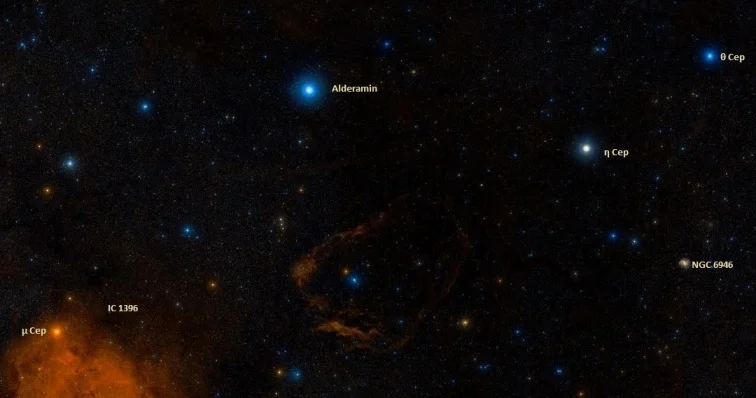
Alderamin, Fireworks Galaxy and IC 1396, image: Wikisky
Constellation
Alderamin is located in the constellation Cepheus. Cepheus is one of the Greek constellations, first catalogued by the Greco-Roman astronomer Ptolemy in the 2nd century CE. It is part of the Perseus family of constellations and represents Cepheus, the king of Aethiopia, husband of Cassiopeia and father of Andromeda, Perseus’ wife.
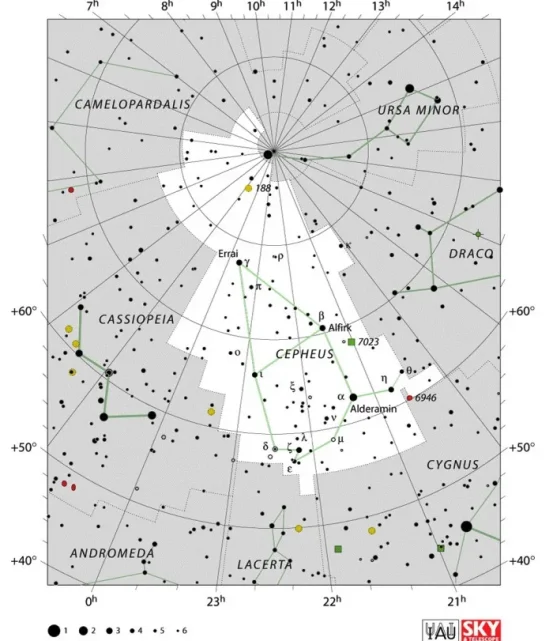
Cepheus constellation map by IAU and Sky&Telescope magazine
Cepheus contains a number of notable stars, among others Delta Cephei, the prototype for Cepheid variables, Beta Cephei (Alfirk), the prototype for Beta Cephei variables, the red supergiants Mu Cephei (Herschel’s Garnet Star) and VV Cephei A, both among the largest stars known, the binary star Omicron Cephei, and the multiple star system Xi Cephei (Kurhah).
Bright deep sky objects in the constellation include the Fireworks Galaxy (NGC 6946), the open cluster NGC 188, the Bow-Tie Nebula (NGC 40), the star-forming nebula NGC 7538, the Cave Nebula (Sharpless 155), the Wizard Nebula (NGC 7380), the Iris Nebula (NGC 7023), the Ghost Nebula (Sh2-136), and the Rosebud Nebula (NGC 7129).
The 10 brightest stars in Cepheus are Alderamin (Alpha Cep, mag. 2.5141), Errai (Gamma Cep, mag. 3.21), Alfirk (Beta Cep, mag. 3.23), Zeta Cephei (mag. 3.35), Eta Cephei (mag. 3.426), Iota Cephei (mag. 3.507), Delta Cephei A (mag. 4.07), Epsilon Cephei (mag. 4.18), Theta Cephei (mag. 4.22), and Mu Cephei (4.23).
Alderamin – Alpha Cephei
| Spectral class | A8Vn |
| Variable type | Delta Scuti (suspected) |
| U-B colour index | +0.12 |
| B-V colour index | +0.21 |
| Apparent magnitude | 2.5141 |
| Absolute magnitude | 1.57 |
| Distance | 49.05 ± 0.08 light years (15.04 ± 0.02 parsecs) |
| Parallax | 66.50 ± 0.11 mas |
| Radial velocity | -10 km/s |
| Proper motion | RA: +150.55 mas/yr |
| Dec.: 49.09 mas/yr | |
| Mass | 1.74 M☉ |
| Luminosity | 17 L☉ |
| Radius | 2.3 R☉ |
| Temperature | 7,740 ± 170 K |
| Rotational velocity | 246 km/s |
| Surface gravity | 3.99 cgs |
| Constellation | Cepheus |
| Right ascension | 21h 18m 34.7715s |
| Declination | +62° 35′ 08.061″ |
| Designations | Alderamin, Alpha Cephei, α Cep, 5 Cephei, HD 203280, HR 8162, HIP 105199, SAO 19302, BD +61°2111, Gl 826, GC 29848, GCRV 13408, PPM 22755, GCTP 5139.00, FK5 803, CCDM J21186+6236A, AG+62° 1226, 2MASS J21183475+6235081, IRAS 21174+6222, AAVSO 2116+62, TYC 4252-1870-1 |